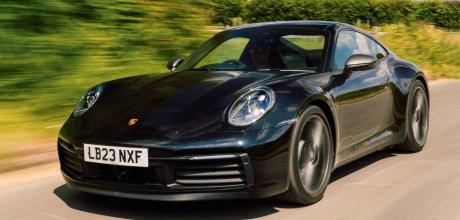2024 Porsche 911 Carrera T 992
Porsche’s second iteration of the 911 Carrera T has arrived in the UK at long last, so does it improve on the original?
New Carrera T first drive
At last, the 992 Carrera T is reaching UK shores – so is the beefed-up base 911 the pick of the current range?
There are 25 differing choices on the Porsche configurator for the 911. Sitting here in front of the online tool is like being a kid marvelling at the contents of a pick ’n’ mix cabinet. There are the Carrera models, be it regular or Carrera S, and these are the foundation mainstays in the line-up. Think of them as the Cola bottles: the Carrera is regular sized and non-fizzy; the Carrera S adds some fizzy coating to that; and the GTS throws in some size variations in combination with the S’s fizz.

Those Turbos are the Sherbet Lemons: familiar shaped and a solid performer, with a wild buzz inside when you crunch through that fine, tasty exterior. The GT3 and RS? They’re Flying Saucers: a lightweight package that once inside mainlines the intense hit you’re really after. The Dakar’s unquestionably a Refresher. It’s tough as hell, but a fabulous all-rounder that’s worth the effort.
“The Carrera T is about as convincing an argument you could ever make that nobody needs more than 400hp”
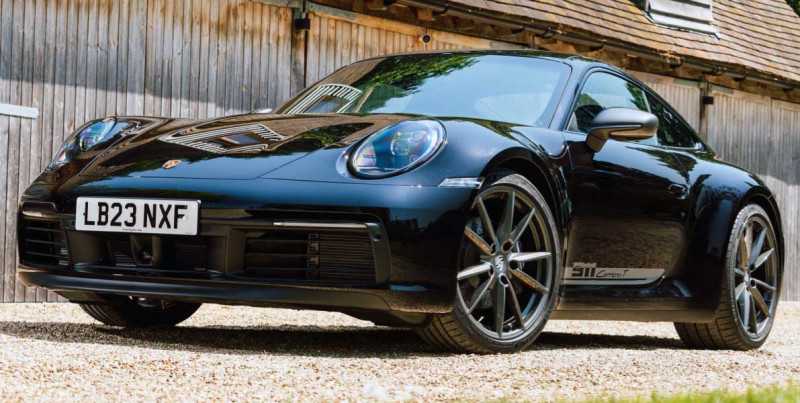
All of which leaves me pondering what the Carrera T is. Sitting between the Carrera and Carrera S, it gains some of the S’s equipment possibilities, as well as option combinations unavailable elsewhere with the Carreras. It does without the bigger output of the Carrera S engine and there’s only one body here – a Coupe – although it brings with it the option of either PDK or manual transmissions. This makes the car the only ‘low’-powered Carrera to be offered with a stick and three pedals. The Carrera T, then, is a pick ’n’ mix within a pick ’n’ mix, with an eye on the scales as well as the price.

You’ll pay no more regardless of the transmission choice, but if you go for the PDK, it shares its gear ratios and final drive with the S. Here, power to the rear wheels is via an electronically controlled limitedslip differential and Porsche Torque Vectoring Plus. The manual car utilises a lesser mechanical limited slip differential and Porsche Torque Vectoring, minus the Plus – and a gear ratio of seven instead of the PDK’s eight. It also shares its ratios with the S, with the T not gaining a differing final drive here as it did with its 991 predecessor.
You’ll get a quicker 911 T in PDK guise, with the 0-62mph dropping from 4.5 seconds in the manual to 4 seconds dead. Get above that benchmark sprint in either and the 992 T is a 180mph+ capable car. Porsche states 181mph but, as ever, we don’t doubt that could be bettered in perfect conditions.
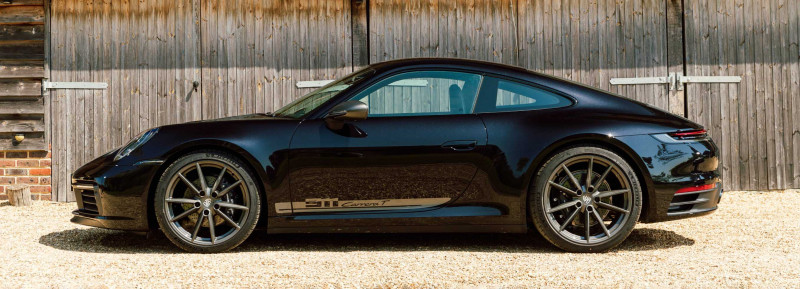
In standard guise, without any other options added, that manual T drops 35kg off the kerb weight of a PDK-equipped Carrera T. With seven gears, a stick and the third pedal, the manual is just 1,470kg. Interestingly, that’s a mere 10kg less than what Porsche quotes for a manual Carrera S. The additional weight of the PDK brings the Carrera T up to 1,505kg, which is coincidentally the same weight as the standard Carrera. Much like the lightly held bag reducing the overall weight of confectionery at the Pick ’n’ Mix payment scales, there’s clearly some Porsche subterfuge in the T’s weight losses here, despite items such as a standard fit lightweight battery, thinner glass and the loss of sound deadening. The body – like every 992 – is wide, with the slimmer, snake-hipped 911 no longer a possibility in this generation. That doesn’t help with the T’s mass and is another reason to love its 991 predecessor even more, because it’ll be the last 911 to come with a narrow body – assuming Porsche doesn’t resurrect the option, of course.
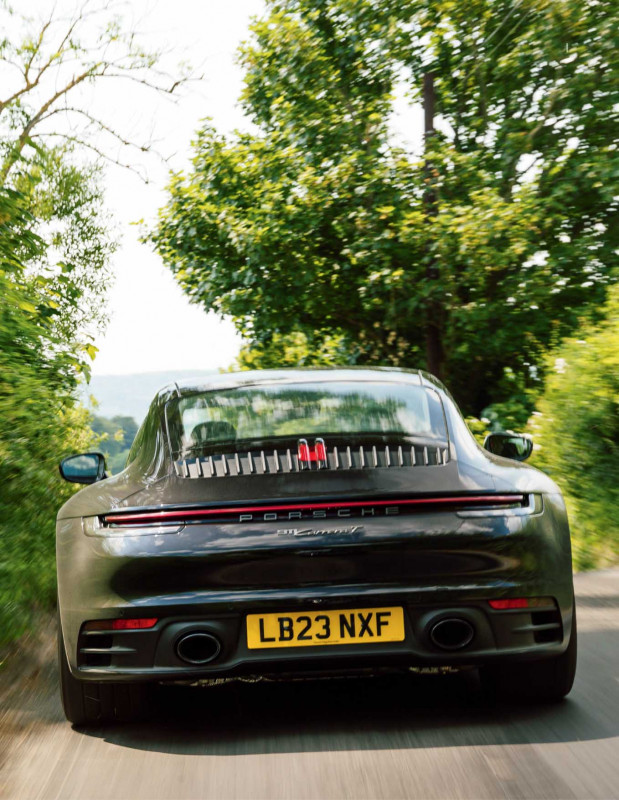
While Porsche’s curation of parts for the 991 Carrera T took time to understand, it was eventually revealed to be a beguiling driver’s choice that felt more than the sum of its lesser parts. The 992’s quicker to comprehend because of the T before it, and it follows its predecessor’s ideal, with a less-is-more approach. It drops a bit of weight and adds some sharpness in its pursuit of purity.
There’s the loss of the back seats, the aforementioned fitting of thinner glass and the removal of some sound deadening, and there’s also the possibility to option the fixed bucket seats. Removing (or adding, depending on your viewpoint) those rear seats is a no-cost option, but the buckets – which require no rear seats behind them – increases the list price by a not-insignificant £4,356. To that you can expect to pay a further £2,178 if you’re sold on the idea of a 3D-printed bodyform bucket. This drops some more weight, and the driver deeper into the seat itself.
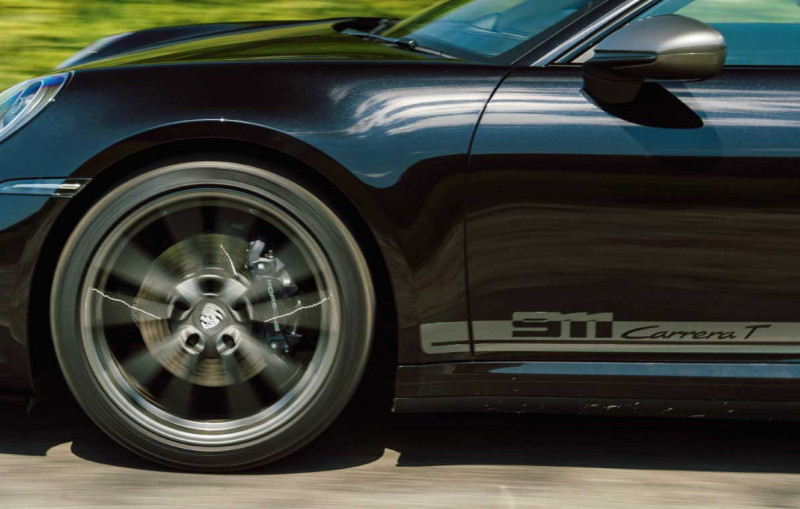
While I’m a huge fan of bucket seats in 911s, the hefty price increase and the lack of the possibility to have more than one passenger makes them difficult to justify in a car that needs to fit a road car brief, rather than something with the sort of purposeful intent of a GT product. That, and getting in Ian Harris’s 992 Carrera T convinces me that the standard Sports Seats here, with the Sport-Tex interior package, is the right choice. There’s sculpting enough to hold without it being so embracing in its clutch to make it a compromise, which again, in a Carrera with its more daily-likely brief, is a serious consideration. While the seats delight I can’t deny I’m slightly disappointed in seeing the stubby PDK lever protruding out from between the front seats rather than a manual lever. Editor Lee Sibley asserts that the majority of early Ts have been so equipped, in the UK at least, and this is indeed one of the earliest customer cars. That it gives us reason to re-visit the T again when so equipped is no bad thing, either. Elsewhere, inside it’s all familiar 992, with the odd T signifier. Ian has sensibly kept the options minimal, which suits the T. I’m inclined to agree. Indeed, looking through the configurator the T really is a 911 that I could genuinely buy without ticking any cost options. That said, I’d be tempted, as here, by the Burmester audio (the priciest extra on this car), followed by the choice of rear-axle steering.
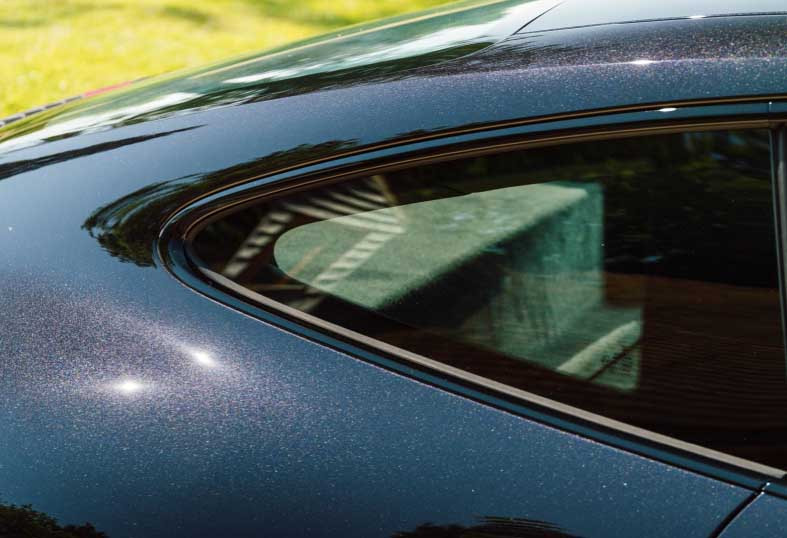
The few degrees that the rear-axle steering contributes to the trajectory of the Carrera T is undoubtedly welcome and proven in every application I’ve ever experienced it in, but similarly it’s slightly at odds with the core simplicity of the T, if not its driver appeal. And there’s plenty of that, because from the second you start the T there’s a subtle, but real feeling that it’s a little bit different.
The 3.0-litre flat six’s timbre is more obvious in the T’s interior, even when sitting idling. It’s not overt, but just a bit clearer – the loss of the rear seats and the standard fitment of a sports exhaust no doubt contributing to that.
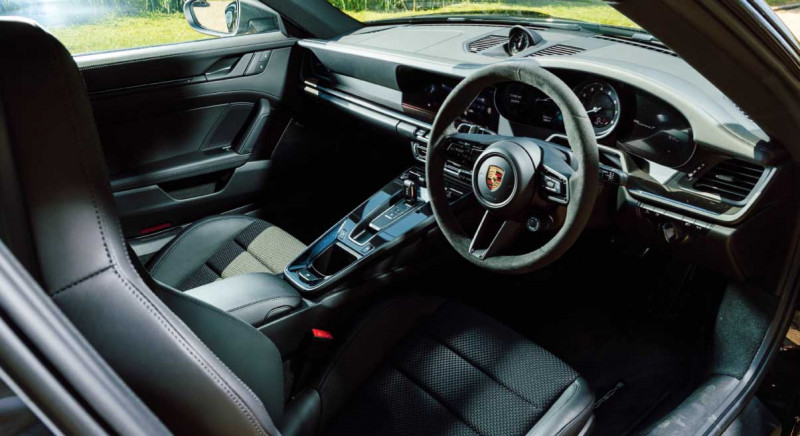
Power, if you need reminding, is 385hp, and that peak output is produced at 6,500rpm. Torque, thanks to the turbocharging of the 3.0-litre flat six, is abundant: a peak 450Nm of twist arrives at just 1,950rpm and hangs around until 5,000rpm. The first time you push the accelerator to the bulkhead you’ll wonder why Porsche needs to offer anything with more power. It’s a fast car, its speed easily gained, particularly with the speed of the PDK’s shifts assisting that acceleration, whether you’ve left it to its own devices in auto or, as you should, pushed the ‘M’ button behind that still oddly proportioned PDK selector. You can then use the paddles that are situated perfectly on the steering wheel to swap ratios with the speed of a hummingbird’s wingbeat. We’re in Sussex, England, on roads I used to frequent when I lived in the area a few years back.
Time’s not been kind to the surfaces here – or indeed, anywhere in the UK. Our tarmac is a shambolic mix of lumps, bumps, cracks, crumbling kerbs and wheel-sized potholes that would challenge the Lunar Rover. All of which make the 992 T’s Sport Chassis’ job all the more difficult, with the 10mm drop over Porsche’s standard setup, combined with the 20/21-inch front/rear wheels shod with 35 and 30 section tyres, respectively. I’d be lying if I said the chassis was adept at isolating the worst of what the roads dish up, but it’s easy to be impressed by the quality of the damping and the manner in which the suspension achieves a balance of relative comfort combined with the sort of control you’re after when you have a 3.0-litre turbocharged flat six with 385hp pushing you along.
Individual setting is the choice here. It enables the easy configuration of a softer, more compliant (necessarily so) chassis, combined with the sharper and more defined response from the accelerator and gearshift that selecting Sport or Sport+ brings. Even taking its scale into account, the 911 Carrera T can be hustled down narrow country roads briskly, confident in the knowledge that the steering’s accuracy and speed is such you can place it exactly where you want it to go. Should you need them, the brakes will haul off speed regardless of what you’re asking from them. Here the PDK comes into its own, enabling you not to just keep your hands on the wheel, but to flick up and down the gearbox with impunity. It shifts so seamlessly and quickly, you can be forgiven for taking it for granted. Not that you ever have to be too busy with the transmission, because the reality is that the engine’s ample torque will haul you along at an indecent pace almost regardless of the ratio you’re asking it to pull from. However, you’re missing a trick if you’re not dropping it down to second or even first, and wringing it out right around to its redline. Do that and the Carrera T is about as convincing an argument you could ever make that nobody needs more than 400hp. In reality, anywhere north of 350hp produces a grin-inducing performance.
A brief foray into Sport on the PASM adds unwanted frequency to the ride, disturbing the flow and the fluidity on these roads. It robs the Carrera T of its speed, ruining the experience and underlining just how impressive the ride is in the Normal setting. Ever since PASM has been offered by Porsche there’s been talk that anything above the Normal chassis setting is hopeless on the road, and that’s amplified here. It’s not Porsche’s fault our roads are so embarrassingly poor, but I can’t help but think that for road-orientated models the ability to switch settings is pointless. A bit of movement and compliance on a single setting is arguably enough in this sort of application.
A simpler single setting suspension, with the lowered ride, for a simpler car aimed at drivers, might be a solution. It’d drop some more weight, too, which would be in line with the T’s mantra. It’s a question I’ve asked several times at Porsche: whether all this choice might leave space for a 911 derivative that’s ultimately more T, and more pure in the truest sense than this car – or any current non-GT 911. A car that could and should feel a little bit more special than it is, much like its predecessor.
That’s not knocking the 992 T too much, because it’s been created from what’s possible within the current constraints of the model line-up. That it’s still the Carrera I’d buy underlines that. Impressive as it is when PDK-equipped, I’d have to have it with a manual, rear seats and perhaps forgo the rear-wheel steering at the same time. Choice is a wonderful thing, though, and there’s plenty of it within the 911 range. Regardless of what you pick there’s always something to delight, but the T delights a little bit more, for a little bit less.
ABOVE The Carrera T’s 3.0-litre flat six is capable of 385hp with peak output produced at 6,500rpm. Porsche states that the car’s maximum speed is an impressive 181mph.
ABOVE We found that the standard Sports Seats, with their Sport-Tex centres, provided plenty of driver grip when taking the Carrera T along winding country roads. ABOVE You may need to manage your expectations when selecting PASM in Sport mode – we found it took away from the overall driving experience.
ABOVE The 992 Carrera T comes as standard with lightweight glass aft of the B-pillar. If weight reduction is high on your list of priorities, you can also choose to remove the rear seats, as here


